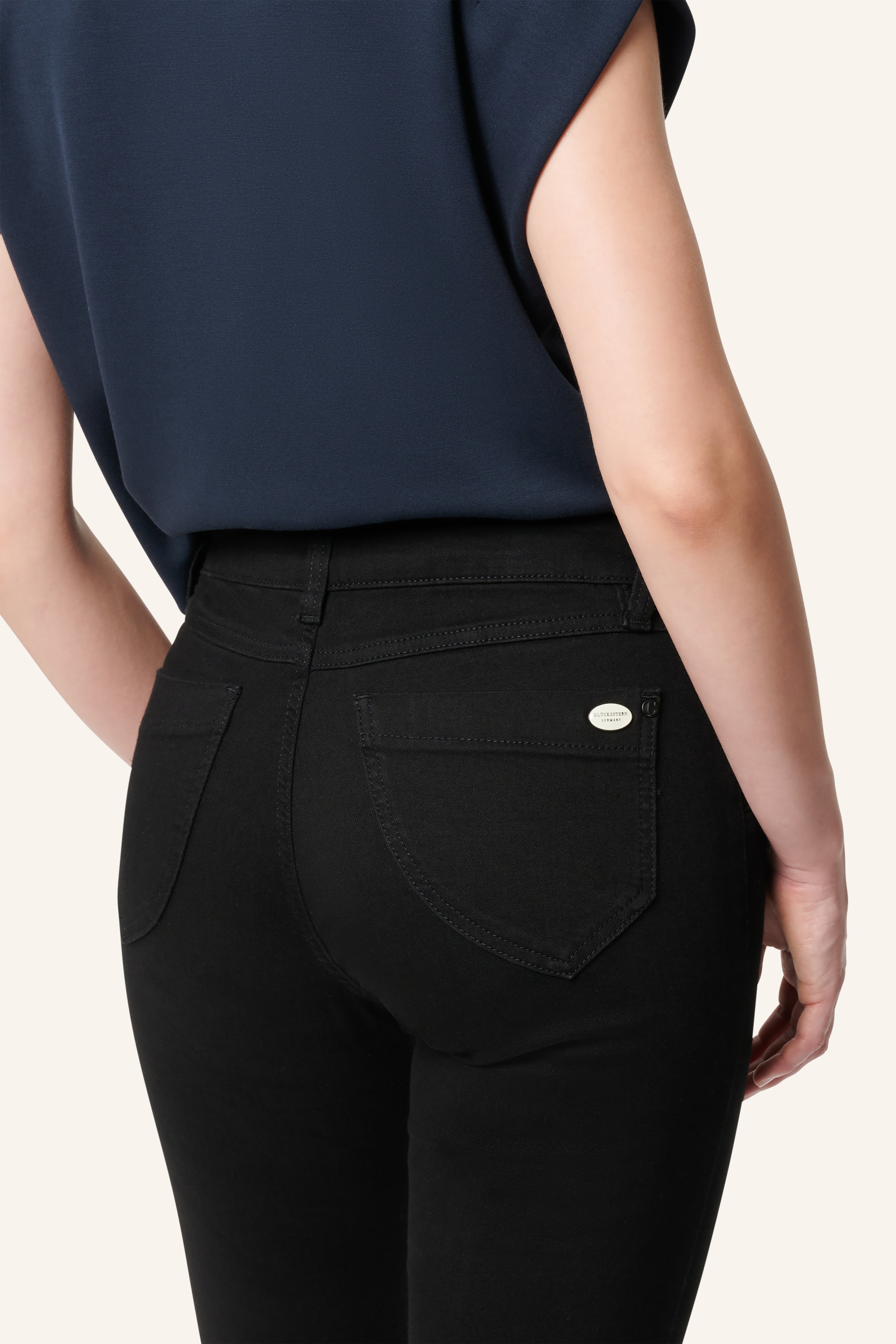
Jeans Production: How Sustainable Fashion Protects the Environment
Jeans are one of the most widely worn garments worldwide. Whether casual or elegant – they go with almost everything. But behind the classic denim pants lies one of the most environmentally damaging production chains in the fashion industry. From high water consumption to harmful chemicals and long transport routes – the production of a pair of jeans has serious ecological and social consequences.
But there is another way. Glücksstern.de shows that sustainable jeans are possible – with eco-friendly materials, short transport routes, and fair production.
The Classic Production Process of Jeans
How much does it actually cost to produce a pair of jeans? The answer varies depending on production conditions and materials. Every pair of jeans involves a complex production process that consumes numerous natural resources and has far-reaching impacts on the environment. From cotton cultivation to the finished jeans, the garment goes through several stages often associated with high water use, chemical treatments, and long transport routes.
Cotton Cultivation – The High Price of Natural Fibers
Cotton is the main material in most jeans, but its cultivation is extremely resource-intensive.
Cotton is one of the most water-intensive crops in the world, and its cultivation for jeans production requires enormous amounts of water. In addition to irrigating cotton fields, the subsequent processing stages – especially dyeing, washing, and finishing – consume large amounts of water.
Besides the high water consumption, large quantities of pesticides and chemical fertilizers are used, which pollute soil and water bodies. This chemical burden not only harms the environment but also the health of agricultural workers. Moreover, large-scale monoculture cultivation leads to soil erosion, causing long-term loss of soil fertility.

Spinning, Weaving, and Dyeing – A Chemical Challenge
After harvesting, cotton is further processed, but this phase also causes significant environmental damage.
First, the fibers are spun into yarn and then woven into denim fabric. The typical blue color of jeans comes from the indigo dyeing process. However, this process often produces toxic residues that are discharged untreated into rivers in many production countries. The chemical dye baths often contain heavy metals and other environmentally harmful substances, which contaminate water sources and disrupt ecosystems.
To ensure the color does not fade, jeans are chemically treated. This involves using heavy metals and formaldehyde – substances that are not only hazardous to health but also accumulate in the environment.
Sustainable dyeing and processing methods help minimize environmental impacts. Learn more about our sustainable jeans.
Washing and Finishing – For the Perfect Look at the Environment's Expense
To achieve the popular used or vintage look, jeans undergo various treatments that often involve significant water and chemical use.
One of the most common methods is stonewashing, where jeans are washed with pumice stones. This creates the desired abrasion but consumes large amounts of water and releases fine dust particles that can be harmful to workers' health.
Even more problematic is sandblasting, used to artificially age jeans. Fine sand particles are shot at the fabric under high pressure, releasing harmful dust and posing serious health risks to workers. Although banned in many countries, this method is still used illegally in some cases.
Alternatively, jeans are treated with chlorine or potassium permanganate to create faded effects. These chemicals are not only dangerous for workers but can also cause long-term environmental damage if not properly disposed of.
Transport Routes – A Pair of Jeans Travels Around the World
The fashion industry is highly globalized, and a single pair of jeans often travels thousands of kilometers before reaching stores or online shops.
In many cases, cotton is grown in the USA, India, or China, processed into fabric in Asian countries like Vietnam or Bangladesh, sewn in other countries, and finally shipped or flown to the sales regions.
These long supply chains significantly contribute to global CO₂ emissions. Air transport is especially problematic, as it emits far more climate-damaging gases than sea transport.
Packaging and Distribution – Plastic No One Needs
Beyond the environmental impact of production, packaging and distribution create additional problems. Many jeans are individually wrapped in plastic for protection during transport. These packages are often single-use and end up directly in the trash.
Shipping also generates waste through cardboard, packing materials, and labels. In an industry that produces billions of garments annually, these materials add up to massive amounts of waste that are difficult to recycle.
Resource Consumption and Environmental Impact
The production of a pair of jeans has far-reaching ecological effects that are often underestimated. The water usage is enormous, toxic chemicals pollute soils and rivers, and the long transport routes significantly increase CO₂ emissions. Added to this is the issue of microplastics and textile waste, which harm our environment in the long term.
Fast fashion exacerbates these impacts: jeans are produced ever more cheaply, using low-quality materials, and discarded after a short time. The consequences for people and the planet are severe.
Water Consumption – The Invisible Burden of Every Pair of Jeans
Up to 10,000 liters of water are needed to produce a single pair of jeans. This is especially problematic in regions with water scarcity, where cotton plantations consume valuable resources and entire river systems dry up.
Most of the water is used not only for cotton cultivation but also for subsequent processing: dyeing, washing, and finishing a pair of jeans consume large amounts of water – often without sustainable wastewater treatment.
Chemicals – A Threat to the Environment and Health
Many jeans contain harmful dyes, plasticizers, and other chemicals that are problematic for both the environment and human health.
During dyeing, toxic substances like heavy metals and synthetic dyes often end up untreated in rivers. This not only affects local ecosystems but also the health of people who rely on these water sources. The use of chlorine and potassium permanganate in bleaching jeans is particularly problematic – substances that can cause respiratory issues and skin irritation.
Microplastics & Waste – An Underestimated Problem
Many modern jeans contain synthetic fibers like polyester or elastane, which release microplastic particles into the water when washed. These particles end up in rivers and oceans, are consumed by animals, and accumulate in the food chain.
Moreover, the fast fashion industry generates huge amounts of textile waste. Millions of jeans end up in landfills or are incinerated each year because they are made from low-quality materials or quickly fall out of fashion.
Social Consequences of Jeans Production
Conventional jeans production not only causes environmental damage but also leads to significant social issues. In many production countries, poor working conditions, health risks, and low wages are everyday realities.
Exploitation in Low-Wage Countries
A large portion of jeans is manufactured in countries like Bangladesh, India, or Pakistan, where workers often toil for less than two euros a day. Working hours are long, protective measures are lacking, and the immense pressure from the fast fashion industry forces many factories to keep wages low and ignore safety standards.
Women are particularly affected, as they make up the majority of textile workers and often work under unsafe, exploitative conditions. Trade unions are suppressed in many production countries, leaving workers with little opportunity to fight against poor conditions.
Health Risks for Workers
Certain production methods expose workers to severe health hazards. Sandblasting, used to give jeans an aged look, is especially dangerous. Fine sand particles are blasted onto fabric at high pressure, releasing harmful quartz dust. Workers exposed to this dust are at high risk of developing silicosis (dust lung) – an incurable lung disease.
The use of toxic chemicals in dyeing and washing also endangers health. Many workers come into contact daily with chlorine, potassium permanganate, and heavy metals without sufficient protection like gloves or masks. Long-term exposure can lead to respiratory diseases, skin problems, or even cancer.
Child Labor and Precarious Working Conditions
In many countries, children are part of the textile industry. Especially during cotton harvesting or in sewing factories, they are employed as cheap labor – often under dire conditions. Since children are particularly vulnerable to health damage, this has serious consequences for their development.
Adult workers also suffer from poor working conditions. Lack of job protection, extreme heat in factories, and dangerous machinery frequently lead to accidents and long-term health issues. In many cases, there is no social safety net, and if workers become ill or injured, they often have no financial support.
How Gluecksstern.de Offers Sustainable Solutions
Sustainability in fashion is possible – At Glücksstern, we want to show how it can be done differently. While conventional jeans production causes major ecological and social problems, Glücksstern relies on eco-friendly materials, resource-efficient manufacturing processes, and fair working conditions.
Sustainable Materials
A crucial factor for more eco-friendly jeans is the choice of materials. Glücksstern uses:
-
Organic cotton (GOTS & OEKO-TEX® certified)
Unlike conventional cotton, it grows without synthetic pesticides and uses significantly less water. -
Cellulose fibers like TENCEL™ Lyocell, Modal, and Viscose
These materials come from sustainable forestry and are biodegradable. They offer excellent wearing comfort and are a long-lasting alternative to conventional fibers. -
Hemp and recycled materials
Hemp is naturally resource-saving, grows without pesticides, and is extremely durable. Glücksstern also uses recycled polyester to reduce plastic waste and minimize environmental impact.
Eco-Friendly Production
Not only materials but also the way they are processed makes a big difference. At Glücksstern, we consciously take a different approach:
-
Production in Europe
Instead of global supply chains with high CO₂ emissions, we manufacture in Germany. This drastically reduces transport distances and ensures fair working conditions. -
No harmful chemicals
We use no toxic dyes or dangerous bleaching processes. Only pollutant-free colors and eco-friendly dyeing techniques are applied. -
Resource-saving washing processes
While conventional jeans production consumes enormous amounts of water, we use innovative washing technologies that drastically reduce water and energy consumption. -
Gentle production technologies
Modern laser technologies replace environmentally and health-damaging methods like sandblasting. This creates unique jeans looks – without harming workers or nature.
We want to prove that fashion doesn’t have to come at the expense of the environment or people. With conscious choices of sustainable materials, responsible production, and fair working conditions, every pair of jeans becomes a long-lasting, eco-friendly companion.
Sustainable Fashion Starts with the Right Choice
Conventional jeans production has serious ecological and social consequences. High water usage, harmful chemicals, and long transport routes burden the environment, while workers in many countries suffer under precarious conditions.
With sustainable materials, eco-friendly production processes, and fair working conditions, we at Glücksstern aim to set an example for responsible fashion.
Discover our sustainable jeans – for the environment and for you!


